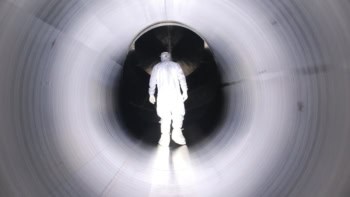Two of the world's biggest particle physics labs - CERN in Europe and Fermilab in the US - are arguing about which of them deserves the credit for the first direct observation of CP violation. The violation of charge-parity (CP) symmetry is thought to be the reason why the universe is made of matter, even though equal amounts of matter and antimatter should have been created in the big bang. Indirect CP violation was first observed in neutral kaons at Brookhaven in the US in 1964, a discovery that lead to a Nobel prize for James Cronin and Val Fitch. CERN and Fermilab are disputing which lab discovered direct CP violation in the decay of neutral kaons.
Last Monday Fermilab issued a press release titled “Fermilab physicists find new matter-antimatter asymmetry”. On Thursday CERN replied with a statement which read: “The CERN physics community offers its congratulations to their colleagues from the KTeV experiment at Fermilab for their exciting new data on the observation of direct CP violation in neutral kaon decays [which] confirm with greater precision the earlier result by the NA31 experiment at CERN.”
Direct CP violation is measured by a ratio known as e‘/e which compares how many neutral kaons – which are bound states of a down quark and an antistrange quark, or an antidown quark and a strange quark – decay into two neutral pions or a pair of charged pions. Pions are bound pairs of up and down quarks or antiquarks.
In May 1988, the NA31 collaboration at CERN reported a value of 33 ± 11 x 10-4 for e‘/e, based on a partial analysis of their data. The final result, published in 1993, was 23 ± 6.5 x 10-4. According to the CERN statement: “These observations were more than three standard deviations from zero, inconsistent with the prediction of the superweak model by Lincoln Wolfenstein, and in support of the direct CP violation expected in the Standard Model.” In 1990, however, the E731 collaboration at Fermilab reported a value of e‘/e that was consistent with zero. The latest result from the KTeV collaboration at Fermilab is 28 ± 4.1 x 10-4.
The Fermilab press release did acknowledge the CERN work, although KTeV cospokesman Bruce Winstein said that the NA31 result “was not yet enough to definitely say it was non-zero”. Later in the release Winstein added: “We are excited to have established direct CP violation, but we also want to emphasize that CERN’s NA31 deserves a share of the credit.”
However, Konrad Kleinknecht of the University of Mainz in Germany puts a different spin on the relative importance of the two experiments. “[The Fermilab result] is a brilliant confirmation of the earlier observations at CERN, and serves credit for that. Finally the 1988 observation on this new symmetry violation is confirmed.”
Further results on direct CP violation are expected from the NA48 experiment at CERN and the KLOE experiment at the Frascati National Laboratory in Italy.



